GE TFM20JRB AA, TFM20JRB WW, TFM22PRB AA, TFM22PRB WW, TFM25CRB BS Owner’s Manual
...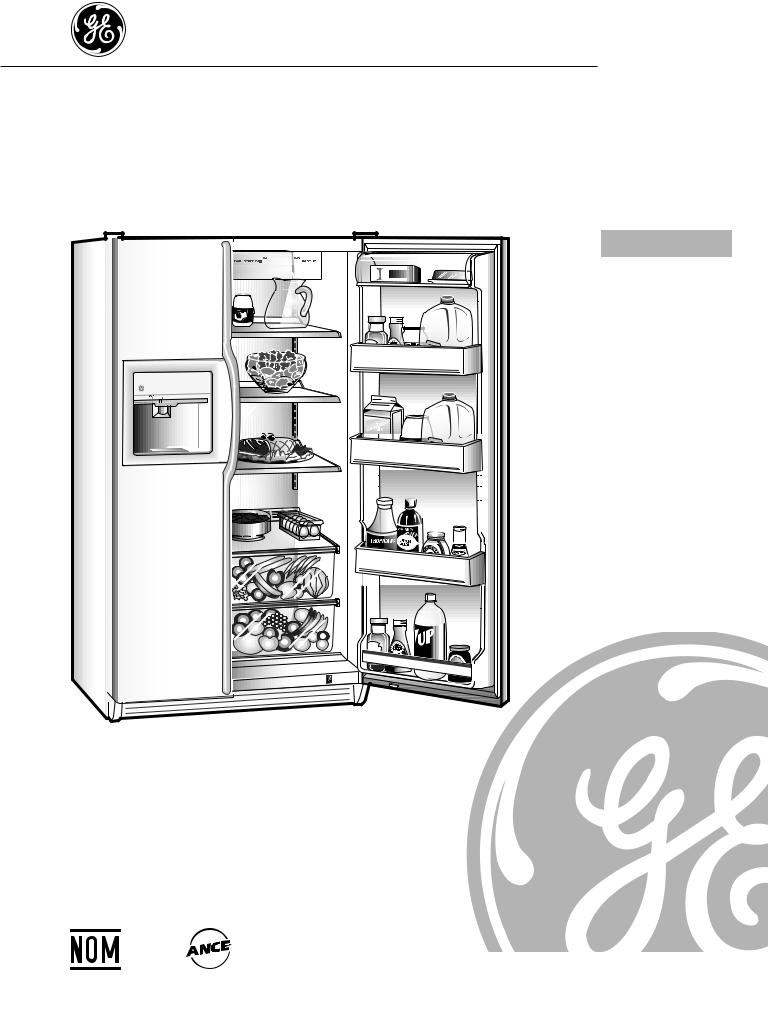
GE Appliances
Side by side
Refrigerators
WATER |
CRUSHED ICE |
Owner’s Manual
Models TFM20JRB AA TFM20JRB WW TFM22PRB AA TFM22PRB WW TFM25CRB BS TFM25PRB BS TFM25PRB AA TFM25PRB WW TFM25KRC AA TFM25KRC WW TFM28PFB AA TFM28PFB BB TFM28PFB WW TFM30PBB WW
Read me to get the most from this appliance!
|
015 |
|
MR |
Part |
|
|
|||
|
|

Safety Information
Safety Precautions . . . . . . . . . . . . . 3 Proper Disposal . . . . . . . . . . . . . . . . 3 Use of Extension Cords . . . . . . . . . . 3 How to Connect Electricity . . . . . . . 4 Use of Adapter Plugs . . . . . . . . . . . 4
Operating Instructions
Controls . . . . . . . . . . . . . . . . . . . . 5-8
Features . . . . . . . . . . . . . . . . . . . 9-14
Automatic Icemaker . . . . . . . . . . . 15
Ice and Water Dispenser . . . . . 15, 16
Care and Cleaning . . . . . . . . . . 17, 18
Replacing the Light Bulbs . . . . . . . 19
Installation Instructions
Preparing to
Install the Refrigerator . . . . . . . 20-22
Troubleshooting Tips
Normal Operating Sounds . . . . . . . 23
Before You
Call For Service . . . . . . . . . . . . 23-26
Customer Service
Performance Data Sheet . . . . . . . . 27
Specifications . . . . . . . . . . . . . . . . 30
Service . . . . . . . . . . . . . . . . . . . . . . 31
Warranty . . . . . . . . . . . . . Back Cover
FOR YOUR RECORDS
Write the model and serial numbers here:
#
#
You can find them on a label inside the fresh food compartment on the top.
READ THIS MANUAL
Inside you will find many helpful hints on how to use and maintain your refrigerator properly. Just a little preventive care on your part can save you a great deal of time and money over the life of your refrigerator.
You’ll find many answers to common problems in the Before You Call For Service section. If you review our chart of Troubleshooting Tips first, you may not need to call for service at all.
2
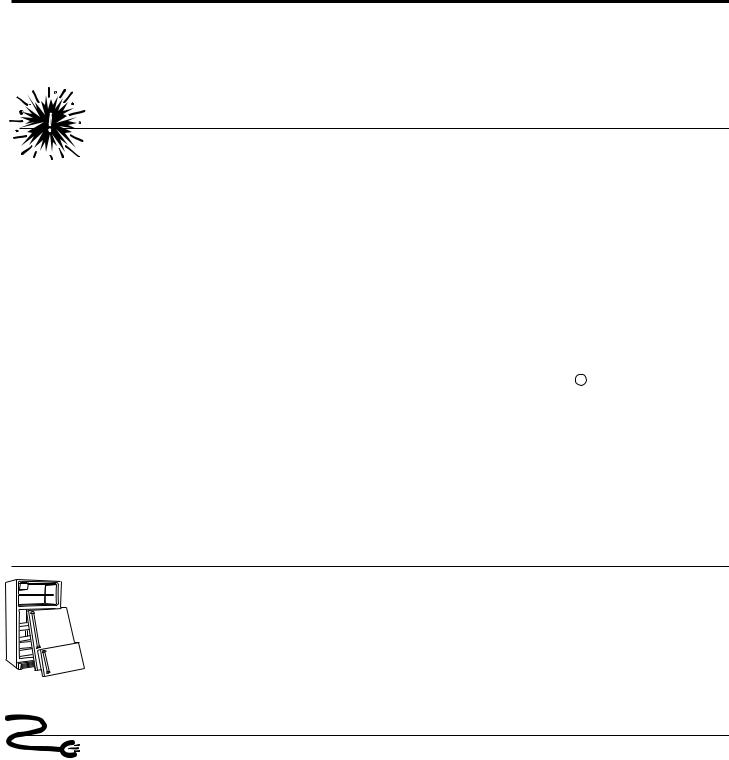
IMPORTANT SAFETY INFORMATION.
READ ALL INSTRUCTIONS BEFORE USING.
 WARNING!
WARNING!
Use this appliance only for its intended purpose as described in this Owner’s Manual.
SAFETY PRECAUTIONS
When using electrical appliances, basic safety precautions should be followed, including the following:
■This refrigerator must be properly installed and located in accordance with the Installation Instructions before it is used.
■Do not allow children to climb, stand or hang on the shelves in the refrigerator. They could damage the refrigerator and seriously injure themselves.
■Do not touch the cold surfaces in the freezer compartment when hands are damp or wet. Skin may stick to these extremely cold surfaces.
■Do not store or use gasoline or other flammable vapors and liquids in the vicinity of this or any other appliance.
■In refrigerators with automatic icemakers, avoid contact with the moving parts of the ejector mechanism, or with the heating
element that releases the cubes. Do not place fingers or hands on the automatic icemaking mechanism while the refrigerator is plugged in.
■Keep fingers out of the “pinch point” areas; clearances between the doors and between the doors and cabinet are necessarily small. Be careful closing doors when children are in the area.
■Unplug the refrigerator before cleaning and making repairs.
NOTE: We strongly recommend that any servicing be performed by a qualified individual.
■ Turning the control to the (off) position does not remove power to the light circuit.
■Do not refreeze frozen foods which have thawed completely.
 DANGER! RISK OF CHILD ENTRAPMENT
DANGER! RISK OF CHILD ENTRAPMENT
PROPER DISPOSAL OF THE REFRIGERATOR
Child entrapment and suffocation are not problems of the past. Junked or abandoned refrigerators are still dangerous…even if they will sit for “just a few days.” If you are getting rid of your old refrigerator, please follow the instructions below to help prevent accidents.
Before You Throw Away Your Old Refrigerator or Freezer:
■Take off the doors.
■Leave the shelves in place so that children may not easily climb inside.
USE OF EXTENSION CORDS
Because of potential safety hazards under certain conditions, we strongly recommend against the use of an extension cord.
However, if you must use an extension cord, it is absolutely necessary that it be an approved 3-wire grounding type appliance extension cord having a grounding type plug and outlet and that meets local regulations and standards. The electrical rating of the cord must be 15 amperes (minimum) and 120 volts.
3

IMPORTANT SAFETY INFORMATION.
READ ALL INSTRUCTIONS BEFORE USING.
 WARNING!
WARNING!
HOW TO CONNECT ELECTRICITY
Do not, under any circumstances, cut or remove the third (ground) prong from the power cord. For personal safety, this appliance must be properly grounded.
The power cord of this appliance is equipped with a 3-prong (grounding) plug which mates with a standard 3-prong (grounding) wall outlet to minimize the possibility of electric shock hazard from this appliance.
Have the wall outlet and circuit checked by a qualified electrician to make sure the outlet is properly grounded.
If the outlet is a standard 2-prong outlet, it is your personal responsibility and obligation to have it replaced with a properly grounded 3-prong wall outlet.
The refrigerator should always be plugged into its own individual electrical outlet which has a voltage rating that matches the rating plate.
This provides the best performance and also prevents overloading house wiring circuits which could cause a fire hazard from overheated wires.
Never unplug your refrigerator by pulling on the power cord. Always grip plug firmly and pull straight out from the outlet.
Repair or replace immediately all power cords that have become frayed or otherwise damaged. Do not use a cord that shows cracks or abrasion damage along its length or at either end.
When moving the refrigerator away from the wall, be careful not to roll over or damage the power cord.
USE OF ADAPTER PLUGS
Because of potential safety hazards under certain conditions, we strongly recommend against the use of an adapter plug.
However, if you must use an adapter, where local codes permit, a temporary connection may be made to a properly grounded 2-prong wall outlet by use of an approved adapter that meets local regulations and standards.
The larger slot in the adapter must be aligned with the larger slot in the wall outlet to provide proper polarity in the connection of the power cord.
When disconnecting the power cord from the adapter, always hold the adapter in place with one hand while pulling the power cord plug with the other hand. If this is not done, the adapter ground terminal is very likely to break with repeated use.
If the adapter ground terminal breaks, DO NOT USE the refrigerator until a proper ground has been established.
Attaching the adapter ground terminal to a wall outlet cover screw does not ground the appliance unless the cover screw is metal, and not insulated, and the wall outlet is grounded through the house wiring. You should have the circuit checked by a qualified electrician to make sure the outlet is properly grounded.
 Read and follow this Safety Information carefully.
Read and follow this Safety Information carefully.
SAVE THESE INSTRUCTIONS
4

About the controls on the refrigerator.
The controls on the refrigerator have either numbers or letters.
A |
B |
C |
D |
E |
1 |
3 |
5 |
7 |
9 |
|
INITIAL |
|
Cold |
SETTING |
Coldest |
Guide
|
|
|
|
|
|
|
|
|
|
|
|
A or 1, the WARMEST setting |
E or 9, the COLDEST setting |
Freezer Control |
Fresh Food Control |
||||||||
|
|
|
|
|
|
|
|
|
|
|
|
Setting the Controls
Initially, set the fresh food control at 5 and the freezer control at 5 or C and allow 24 hours for the temperature to stabilize.
Moving the freezer control to OFF or stops cooling in both the fresh food and freezer compartments but does not shut off electrical power to the refrigerator.
Control settings will vary based on personal preferences, usage, and operating conditions and may require more than one adjustment.
5
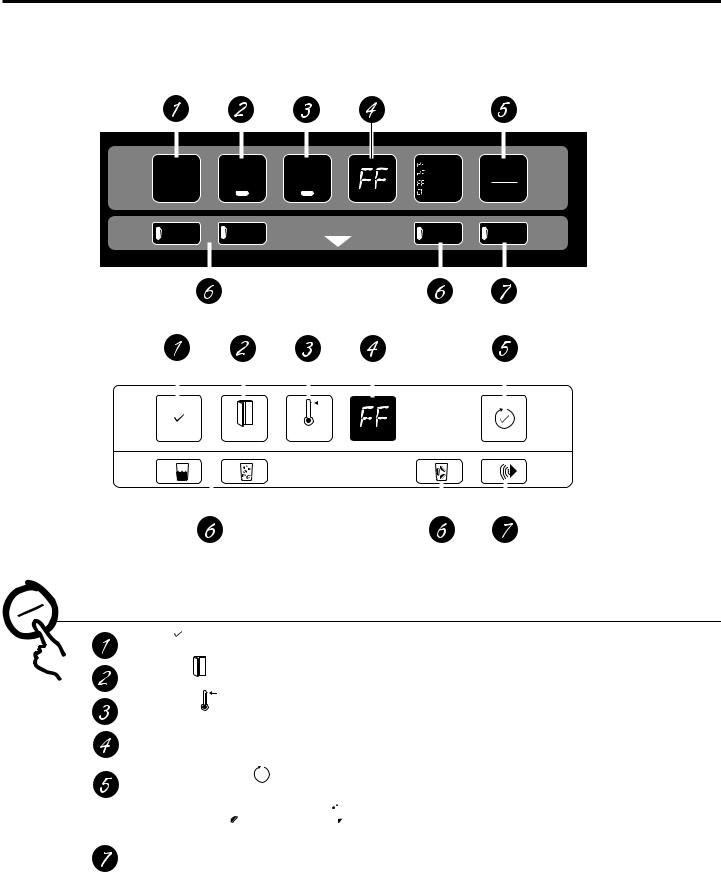
About the controls on the refrigerator.
The Electronic Monitor and Diagnostic System controls dispenser functions and monitors the operation of your refrigerator. On some models, the controls will look like one of the following.
|
|
|
|
|
|
|
DISPLAY |
|
|
|
|
|
|
|
|
|
|
|
|
POWER |
SYSTEM |
||
|
N O R M A L |
|
DOOR |
WARM |
DEFROST |
||||||
|
|
CHECK |
|||||||||
|
|
OPEN |
TEMP |
FREEZER |
|||||||
|
|
|
|
RESET |
|||||||
|
|
|
|
|
|
|
|
ICEMAKER |
|||
|
|
|
|
|
|
|
|
|
|
||
|
CHILLED |
|
CRUSHED |
DISPENSER PUSH BELOW |
CUBED |
DOORALARM |
|||||
|
WATER |
|
|
ICE |
|
|
ICE |
ON/OFF |
|||
|
|
|
|
|
|
|
|
|
|
|
|
|
|
|
|
|
|
|
|
|
|
|
|
|
|
|
|
|
|
|
|
|
|
|
|
Monitor
NORMAL |
detected by the diagnostic system. |
DOOR OPEN |
|
WARM TEMP |
temperature is above normal. |
Flashing diagnostic codes. What these codes mean—and what to do when they appear—is explained more thoroughly on the following pages.
SYSTEM CHECK-RESET  reviews the diagnosis of four coded functions and allows you to erase codes from the display.
reviews the diagnosis of four coded functions and allows you to erase codes from the display.
 Select CUBED ICE
Select CUBED ICE  , CRUSHED ICE
, CRUSHED ICE  or WATER
or WATER  and the signal light confirms your choice.
and the signal light confirms your choice.
DOOR ALARM 
 lights up when the beeper has been set to sound after either door has been open 30 seconds.
lights up when the beeper has been set to sound after either door has been open 30 seconds.
6

When Your Refrigerator Is First Plugged In
All panel lights come on for five seconds, a beep sounds, and lights go off except as follows:
■PF flashes in the display. Touch
SYSTEM CHECK-RESET to erase it.
■NORMAL glows.
■WARM TEMP glows until the refrigerator cools down. It goes off when proper food-keeping temperature is reached.
■Door alarm beeper is activated and
DOOR ALARM glows.
■CRUSHED ICE glows.
■DOOR OPEN flashes if either door is open, goes out when doors are shut.
■Night light in ice and water dispenser is off.
How to Set the Door Alarm
DOORALARM
ON/OFF To set the alarm press DOOR ALARM until it glows.
The control beeps if either door is open for more than 30 seconds.
The light goes out and the beeping stops when you close the door.
WARM TEMP
Why the WARM TEMP Light Glows
At first, it’s probably because your newlyinstalled refrigerator hasn’t completely cooled down yet. Wait a few hours for it to cool, and then the light will go out.
From then on, WARM TEMP will glow whenever temperatures inside get too high for proper food storage. If this happens, open the doors only when absolutely necessary, and close them as quickly as possible.
As soon as inside temperatures return to normal, the light goes out.
If WARM TEMP reappears and stays on for longer than 4 hours, call for service.
SYSTEM
CHECK
RESET
How the Monitor and Diagnostic System Works
The diagnostic code flashes and the control beeps when something starts to go wrong.
If more than one coded function requires attention at the same time, the one with the highest priority will be displayed first.
Pressing SYSTEM CHECK-RESET will erase two codes immediately—PF and CI. The dE and FF codes can only be erased by pressing SYSTEM CHECK-RESET after the condition that caused the code to flash has been corrected.
SYSTEM CHECK-RESET will also evaluate all other coded functions. If NORMAL is lit during the displaying of a code, that function is operating properly.
7

About the controls on the refrigerator.
What the Codes Mean
Check your frozen food. Has any of it started to thaw? A package may be holding the freezer compartment door open. Don’t open the door more often than absolutely necessary while this code is displayed. Touching SYSTEM CHECK-RESET after the freezer compartment temperature has returned to normal will erase the code.
Power to the refrigerator has been interrupted for more than two seconds. Check the condition of food in both the fresh food and freezer compartments. Touch SYSTEM CHECK-RESET to erase the code.
There is no fault with the refrigerator when the PF code flashes.
Check the icemaker. Ice clumps in the storage bin may have stalled the icemaker. Follow corrective measures described in Troubleshooting Tips. If water supply to the icemaker is not connected or not turned on, make sure the icemaker feeler arm is in the STOP (up) position. The code stops flashing when problem is corrected or
SYSTEM CHECK-RESET is touched.
Something is wrong with the defrost system—keep doors closed to retain cold and call for service. The code flashes until problem is corrected.
8
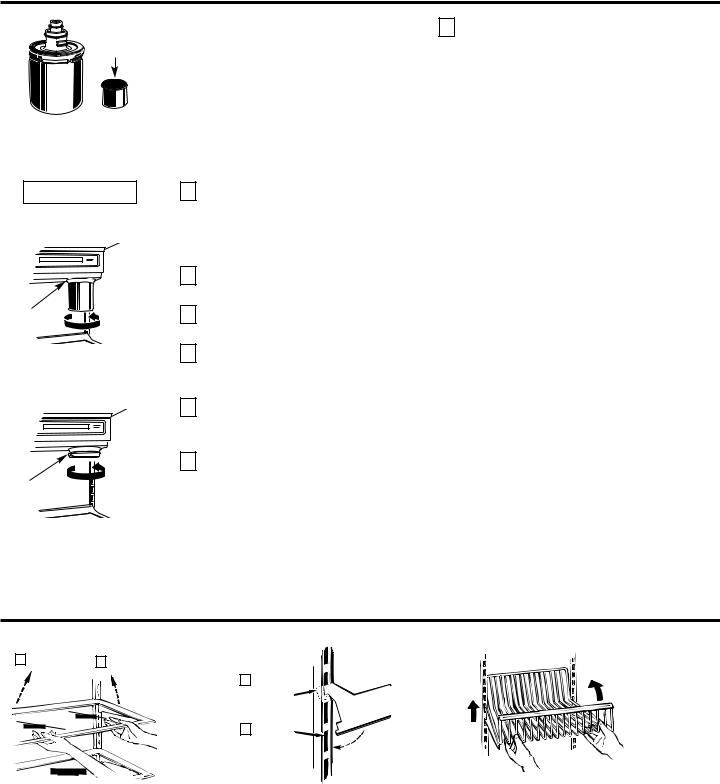
About the water filter cartridge. (On some models)
Plastic Cap
Discard the plastic cap.
REPLACE FILTER BY:
(month-year)
replace every 6 months
Cartridge
Holder
Place the top of the cartridge up inside the cartridge holder and slowly turn it to the right.
Filter Bypass Plug
The water filter cartridge is located in the upper right-hand corner of the fresh food compartment, right below the temperature controls.
The filter cartridge should be replaced every six months or earlier if the flow of water to the water dispenser or icemaker decreases.
Installing the Filter Cartridge
1 If you are replacing the cartridge, first remove the old one by slowly turning it to the left. Do not pull down on the cartridge. A small amount of water may drip down.
2 Remove and discard the plastic cap from the new cartridge.
3 Fill the replacement cartridge with water from the tap.
4 Apply the month and year sticker to the cartridge to remind you to replace the filter in six months.
5 Place the top of the cartridge up inside the cartridge holder. Do not push it up into the holder.
6 Slowly turn it to the right until the filter cartridge stops. DO NOT OVERTIGHTEN. As you turn the cartridge, it will automatically raise itself into position.
7 Run water from the dispenser for 1 minute (about a half gallon) to clear the system and prevent sputtering.
NOTE: A newly-installed water filter cartridge may cause water to spurt from the dispenser.
Filter Bypass Plug
You must use the filter bypass plug when a replacement filter cartridge is not available. The dispenser and the icemaker will not operate without the filter or filter bypass plug.
Replacement Filters:
To order additional filter cartridges, contact your dealer.
FXRT—Chlorine, Taste and Odor
FXRC—Chlorine, Taste and Odor—
Lead and Cysts
About the shelves, baskets and bins. (Not all features are on all models.)
2 Lift up and out 1 |
Tilt up |
|
|
|
1 |
Insert |
|
|
|
top hook |
|
|
2 |
Lower to |
|
|
|
lock in place |
|
To Remove |
|
To Replace |
Freezer Basket |
9
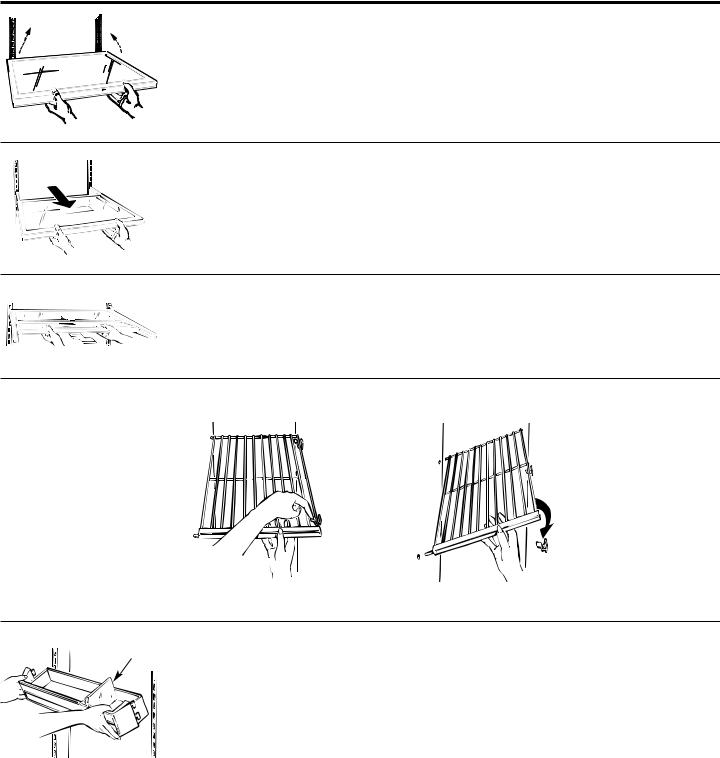
About the shelves, baskets and bins.
Spillproof Shelves
Spillproof shelves have special edges to help prevent spills from dripping to lower shelves.
Slide-Out Spillproof Shelf
The slide-out spillproof shelf allows you to reach items stored behind others.
Make sure you push the shelves all the way back in before you close the door.
Quick Space Shelf
This shelf splits in half and slides under itself for storage of tall items on the shelf below.
Freezer Shelves
To Remove To Replace
Divider Bins on the Fresh Food Compartment Door
To remove: Lift bin straight up until mounting hooks disengage.
To replace or relocate: Select desired shelf height, engage bin’s hooks in slots on the tracks of the door, and push in. Bin will lock in place.
The divider helps prevent tipping, spilling or sliding of small items stored on the door shelf. Place a finger on either side of the divider near the front and move it back and forth to fit your needs.
(continued on next page)
10

Bins on the Fresh Food Compartment Door (continued)
Adjustable bins can easily be carried from refrigerator to work area.
To remove: Tilt the bin up and pull out on the molded supports until it comes completely out of the door.
To replace or relocate: Select desired shelf height, engage the bin in the molded supports of the door and slide the bin in. The bin will hook in place.
The divider helps prevent tipping, spilling or sliding of small items stored on the door shelf. Place a finger on either side of the divider near the front and move it back and forth to fit your needs.
To remove fixed bins, first remove the food in the bins. Then, grasping the bin at each end, push in at the bottom as you lift and pull out at the top.
Deep Door Shelves in the Freezer Compartment
Detachable shelf extenders deepen and enclose fixed door shelves, providing more storage room and greater storage flexibility.
To remove: Lift the shelf extender straight up until the mounting hooks come out of the slots in the door.
To replace: Line up the hooks with the slots in the door and push in and down.
About the additional features. (Not all features are on all models.)
Quick Serve™ System
CAUTION: Dishes and lids are not designed for use on the range top, broiler or in the regular oven. Such use can be hazardous.
Quick Serve™ dishes fit into a spacesaving rack under the shelf. The rack can be relocated anywhere in the fresh food compartment.
Dishes and lids are safe for use in microwave ovens, refrigerators and freezers.
Do not use when cooking high-fat foods, such as bacon, and high-sugar foods, such as candy and syrup. The high temperatures of the fat and sugar can cause bubbles to form on the inside of the dish.
11
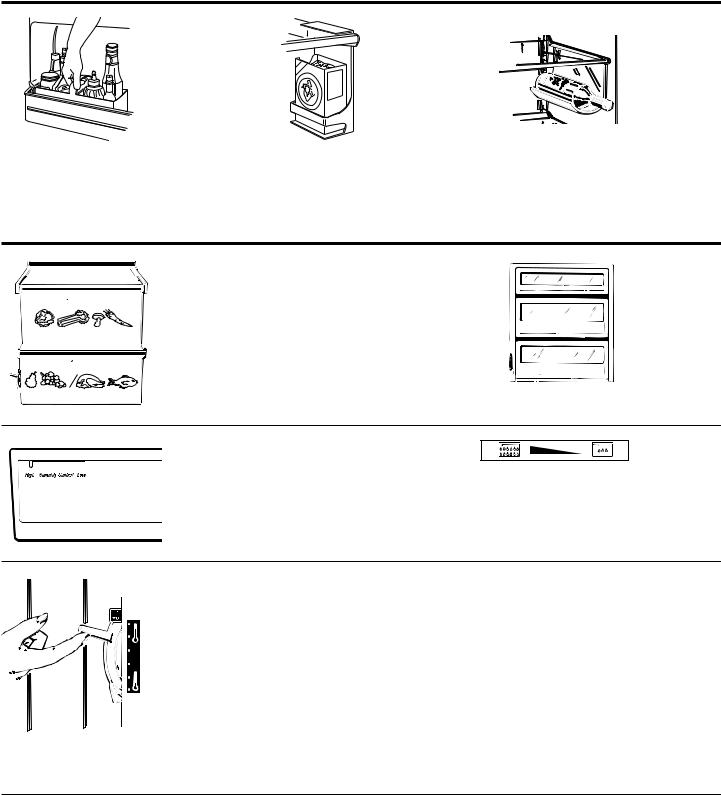
About the additional features. (Not all features are on all models.)
Condiment Caddy |
Baking Soda Holder |
Removable Wine Rack |
About the storage drawers. (Not all features are on all models.)
Fruit and Vegetable Drawers
Excess water that may accumulate in the bottom of the drawers should be emptied and the drawers wiped dry.
Adjustable Humidity Drawers
Slide the control all the way to the High or  setting to provide high humidity recommended for most vegetables.
setting to provide high humidity recommended for most vegetables.
Slide the control all the way to the Low or  setting to provide lower humidity levels recommended for most fruits.
setting to provide lower humidity levels recommended for most fruits.
Normal Convertible Meat Drawer
The convertible meat drawer has its own cold air duct to allow a stream of cold air from the freezer compartment to flow around the drawer.
The variable temperature control regulates the air flow from the freezer compartment.
Coldest
Set control lever down to the coldest setting to store fresh meats. If lever is left in meat position for a long period of time, some frost may form on the inside of the drawer.
Set control lever up to convert the drawer to normal refrigerator temperature and provide extra vegetable storage space. Cold air duct is turned off. Variable settings between these extremes can be selected.
Sealed Snack Pack
The sealed snack pack can be moved to the most useful location for your family’s needs.
12
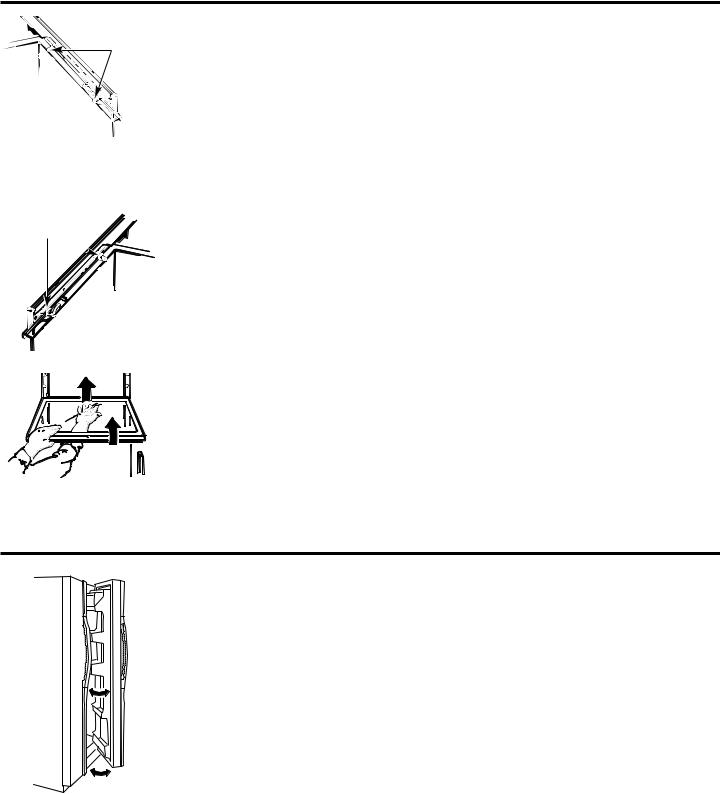
About storage drawer removal. (Not all features are on all models.)
Drawer
Guides
When replacing the drawers, make sure you slide them through both drawer guides on the right or left side depending on your model.
Drawer
Guides 
Left Side
Drawer Removal
Drawers can easily be removed by tilting up slightly and pulling past the stop location.
Remove the door bins from the fresh food door before removing the drawer.
To remove the shelf above the top drawer, first remove the top drawer and any food on the shelf. Then tilt the shelf up at the front and lift it up and out of the tracks.
To replace the shelf, raise the shelf front slightly and place the top hooks in the lowest large track slots. Then lower the front of the shelf until it is level.
To remove the drawers when the fresh food compartment door cannot be opened fully you need to roll the refrigerator forward until the door can be fully opened. In some cases this will require moving the refrigerator to the left as you roll it out.
About the refrigerator doors.
Refrigerator Doors with Special Opening/Closing Feature (on some models)
The refrigerator doors may feel different than the ones you are used to. The special door opening/closing feature makes sure the doors close all the way and are securely sealed.
When opening and closing the door you will notice a stop position. If the door is opened past this stop point, the door will remain open to allow you to load and unload food more easily. When the door is only partially open it will automatically close.
The resistance you feel at the stop position will be reduced as the door is loaded with food.
When the door is only partially open it will automatically close.
Beyond this stop the door will stay open.
13
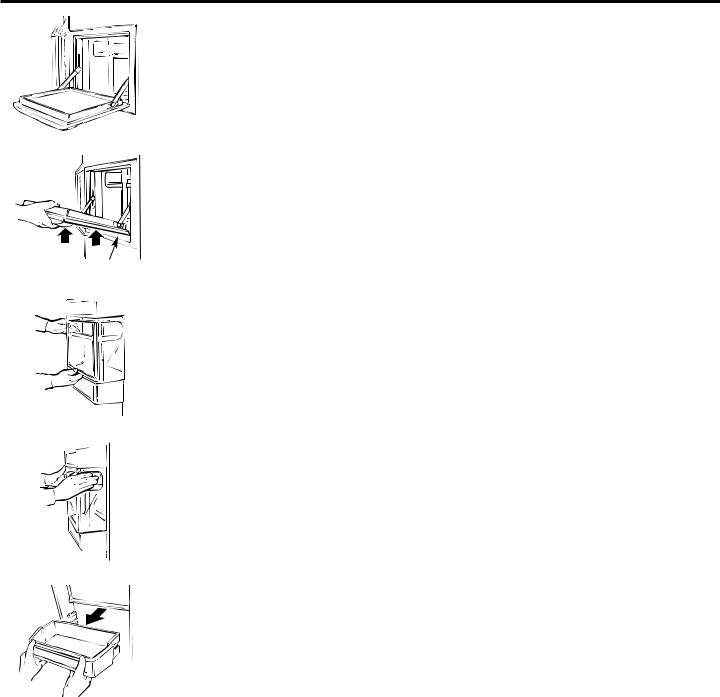
About the refreshment center. (On some models)
The Refreshment Center Compartment stores frequently used items.
When open, the Refreshment Center door provides a convenient work surface. Although durable, the work surface should not be used as a cutting board. Close the door when finished. The upper fresh food compartment light will come on when the Refreshment Center door is opened.
The special design of the door allows you to tilt and lift up the door in order to clean the bottom of the frame.
NOTE: Use caution in closing or using the clean-out feature in the presence of small children.
Bottom of Frame
Cold air entering from the freezer compartment keeps the temperature in the
Refreshment Center Compartment at proper food-keeping levels.
The bin panel limits the amount of cold air that escapes when the Refreshment
Center door is opened. To reach food from the inside, lift the panel up.
To remove the Refreshment Center bin, first remove the panel using the hand holds.
Then remove the bin by lifting it up and out.
14
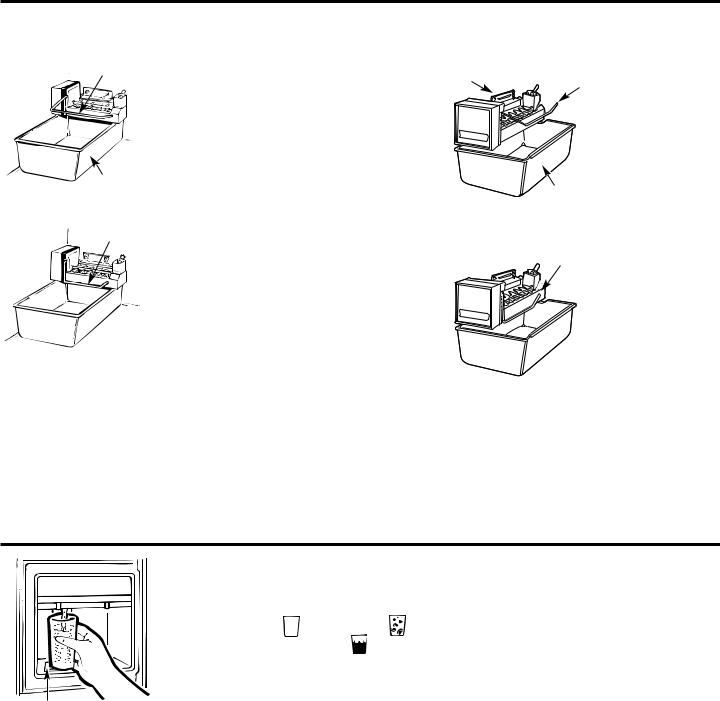
About the automatic icemaker.
A newly-installed refrigerator may take 8 to 12 hours to begin making ice.
Feeler arm in the STOP (up) position
Ice Storage Bin
Feeler arm in the ON (down) position
Automatic Icemaker
On some models the icemaker is in back, on others it is on the side.
The icemaker will produce eight cubes per cycle—approximately 120 cubes in a 24-hour period, depending on freezer compartment temperature, room temperature, number of door openings and other use conditions.
If the refrigerator is operated before the water connection is made to the icemaker, keep the feeler arm in the STOP (up) position.
When the refrigerator has been connected to the water supply, move the feeler arm to the ON (down) position.
The icemaker will fill with water when it cools to freezing. A newly-installed refrigerator may take 8 to 12 hours to begin making ice cubes.
Throw away the first few batches of ice to allow the water line to clear.
Be sure nothing interferes with the swing of the feeler arm.
Feeler arm
Icemaker in the STOP (up) position
Ice Storage Bin
Feeler arm in the ON
(down) position
About the ice and water dispenser. (On some models)
To Use the Dispenser
Press the rim of the glass gently against the dispenser pad.
Select CUBED ICE  , CRUSHED ICE
, CRUSHED ICE
(on some models) or WATER .
The spill shelf is not self-draining. To reduce water spotting, the shelf and its grille should be cleaned regularly.
Spill Shelf
If no water is dispensed when the refrigerator is first installed, there may be air in the water line system. Press the dispenser pad for at least two minutes to remove trapped air from the water line and to fill the water system. To flush out impurities in the water line, throw away the first six glassfuls of water.
A light switch (on some models) turns the night light in the dispenser on or off. The light also comes on when the dispenser pad is pressed. The light in the dispenser should be replaced with a 7 watt maximum bulb when it burns out.
CAUTION: Never put fingers or any other objects into the ice crusher discharge opening.
15

About the ice and water dispenser. (On some models)
Ice Storage Bin
To remove: |
Rotate |
Lift the left corner to free the bin from the shelf and pull the bin straight out while supporting it at front and rear.
To replace:
Drive
Slide the bin back until the tab on the Mechanism bin locks into the slot on the shelf. If the
bin does not go all the way back, remove it and rotate the drive mechanism 1/4 turn. Then push the bin back again until the tab on the bin locks into the slot on the shelf.
Important Facts About Your Dispenser
■Add ice before filling the glass with a beverage.
■Do not add ice from trays or bags to the storage bin. It may not crush or dispense well.
■Avoid overfilling glass with ice and use of narrow or extra-tall glasses. Backedup ice can jam the chute or cause the door in the chute to freeze shut. If ice is blocking the chute, poke it through with a wooden spoon.
■Beverages and foods should not be quick-chilled in the ice storage bin. Cans, bottles or food packages in the storage bin may cause the icemaker or auger to jam.
■Some crushed ice may be dispensed even though you selected CUBED ICE. This happens occasionally when a few cubes accidentally get directed to the crusher.
■After crushed ice is dispensed, some water may drip from the chute.
■Sometimes a mound of snow will form on the door in the ice chute. This condition is normal and usually occurs when you have dispensed crushed ice repeatedly. The snow will eventually evaporate.
■Dispensed water is not ice cold. For colder water, add crushed ice or cubes before dispensing water.
16
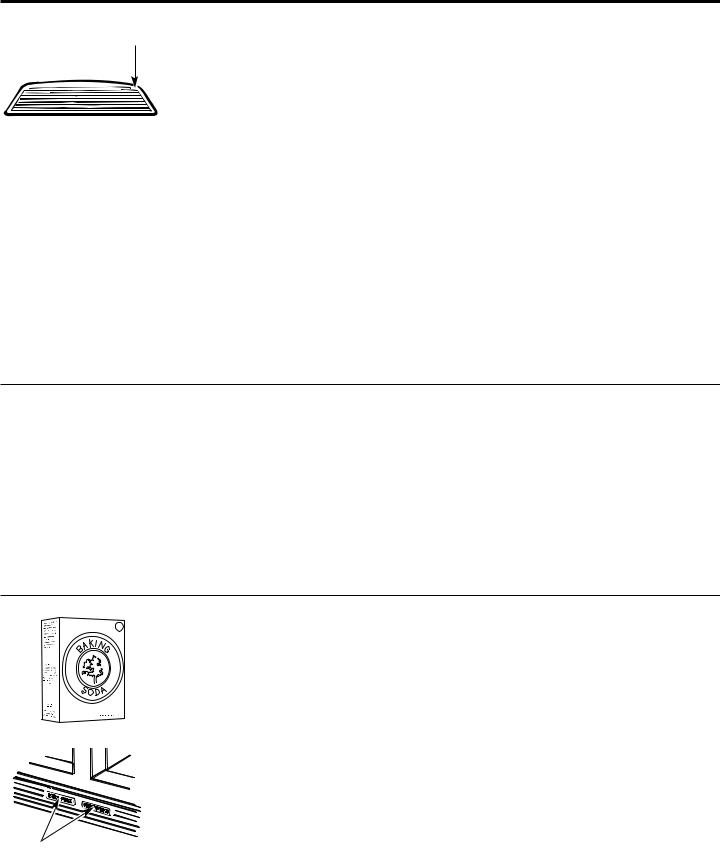
Care and cleaning of the refrigerator.
Press here to remove grille.
Cleaning the Outside
Refreshment Center Compartment door— outside. It’s important that you use only window cleaner without ammonia or a damp cloth to clean the glass and trim. Avoid using wax on the Refreshment Center door.
The dispenser well, beneath the grille, should be wiped dry. Water left in the well may leave deposits. Remove the deposits by adding undiluted vinegar to the well. Soak until the deposits disappear or become loose enough to rinse away.
The dispenser pad. Clean with warm water and baking soda solution—about a tablespoon (15 ml) of baking soda to a quart (1 l) of water. Rinse thoroughly and wipe dry.
HINT: Open the freezer door part way to prevent dispensing of ice or water when cleaning.
The door handles and trim. Clean with a cloth dampened with soapy water. Dry with a soft cloth.
The stainless steel panels and door handles
(on some models) can be cleaned with a commercially available stainless steel cleaner using a clean, soft cloth.
Keep the outside clean. Wipe with a clean cloth lightly dampened with kitchen appliance wax or mild liquid dish detergent. Dry and polish with a clean, soft cloth.
Do not wipe the refrigerator with a soiled dish cloth or wet towel. These may leave a residue that can erode the paint. Do not use scouring pads, powdered cleaners, bleach or cleaners containing bleach because these products can scratch and weaken the paint finish.
Cleaning the Decorator Door Panels (on some models)
Clean these panels using an anti-static cleaner or a mild detergent and water. (Look for anti-static cleaner in electronic or computer departments.) Rinse thoroughly and blot dry with a clean, damp cloth or chamois. Do not use paper towels to wash or dry the panels. Do not use cleaners that contain solvents, such as ammonia, because they can damage the panels.
Shallow scratches and abrasions can be corrected with a good grade of hard automobile paste wax. The wax will fill in any minor surface scratches and will help to maintain the luster of the panels. Apply the wax sparingly and buff lightly with a clean, soft cloth using a circular motion. Do not use a cleaner/wax combination.
|
Cleaning the Inside |
|
To help prevent odors, leave an open box |
|
of baking soda in the fresh food and |
|
freezer compartments. |
|
Unplug the refrigerator before cleaning. |
|
If this is not practical, wring excess |
|
moisture out of sponge or cloth when |
|
cleaning around switches, lights or |
|
controls. |
|
Use warm water and baking soda |
|
solution—about a tablespoon (15 ml) |
|
of baking soda to a quart (1 l) of water. |
|
This both cleans and neutralizes odors. |
Door Magnets |
Rinse and wipe dry. |
|
|
|
Door magnets (on some models) can be |
|
cleaned the same way. |
Refreshment Center Compartment door— inside. Wipe up spills right away. Use one tablespoon (15 ml) of baking soda in one quart (1 l) of water to clean the inside door surface, Refreshment Center bin and inside access door. Rinse, wipe dry.
Avoid cleaning cold glass shelves (on some models) with hot water because the extreme temperature difference may cause them to break. Handle glass shelves carefully. Bumping tempered glass can cause it to shatter.
Do not wash any plastic refrigerator parts in the dishwasher except Quick Serve dishes and lids.
(continued on next page)
17
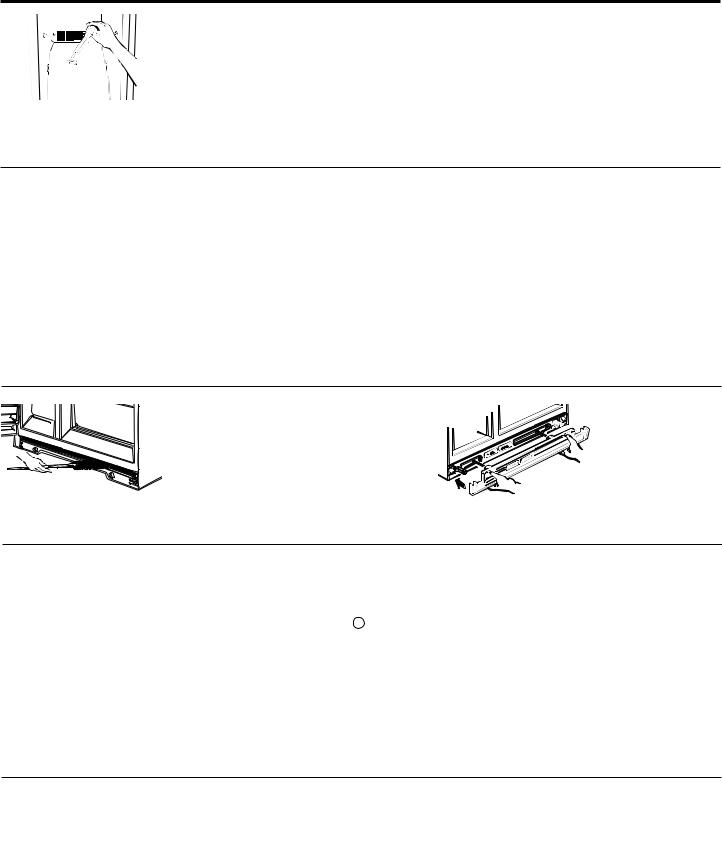
Care and cleaning of the refrigerator.
Cleaning the Inside (continued)
Drain opening in freezer compartment.
(on some models) During yearly cleaning, remove bottom freezer basket and flush a solution of baking soda—
1 teaspoon (5 ml) and 2 cups (500 ml) of hot (not boiling) water— through the drain line with the help of a meat baster.
This will help eliminate odor and reduce the likelihood of a clogged drain line.
If drain becomes clogged, use a meat baster and baking soda solution to force the clog through the drain line.
Behind the Refrigerator
Be careful when moving the refrigerator |
When pushing the refrigerator back, make sure |
away from the wall. All types of floor |
you don’t roll over the power cord or icemaker |
coverings can be damaged, particularly |
supply line (on some models). |
cushioned coverings and those with |
|
embossed surfaces. |
|
Pull the refrigerator straight out and |
|
return it to position by pushing it straight |
|
in. Moving the refrigerator in a side |
|
direction may result in damage to the |
|
floor covering or refrigerator. |
|
Clean the condenser coils at least once a year.
Under the Refrigerator
For most efficient operation, keep the area under the refrigerator clean. Remove the base grille and sweep away or vacuum up dust.
Base grille appearance may vary from your model.
Preparing for Vacation
For long vacations or absences, remove food and unplug the refrigerator. Move the fresh food control to the (off) position, and clean the interior with a baking soda solution of one tablespoon (15 ml) of baking soda to one quart (1 l) of water. Leave the doors open.
Move the icemaker feeler arm (on some models) to the STOP (up) position and shut off the water supply to the refrigerator.
If the temperature can drop below freezing, have a qualified servicer drain the water supply system (on some models) to prevent serious property damage due to flooding.
Preparing to Move
Secure all loose items such as grille, |
Be sure the refrigerator stays in an upright |
shelves and drawers by taping them |
position during moving. |
securely in place to prevent damage. |
|
18

Replacing the light bulbs.
Turning the control to the OFF or |
position does not remove power to the light circuit. |
Fresh Food Compartment—Upper Light
1
2
3
Unplug the refrigerator.
To align the control knobs properly, note position of each knob for proper reassembly, move both knobs all the way to the left, then pull them off.
Remove light shield.
a To remove this type of light shield, pull it straight out.
b To remove this type of light shield, pull bottom of light shield down and forward, then rotate the top up and off.
1 |
3 |
5 |
|
|
|
|
7 |
9 |
|
|
|
|
||
|
|
|
|
FREEZER TEMPERATURE
COLD |
|
OFF |
|
1 |
COLDEST |
5 |
|
3 |
|
* |
7 |
9
ProfileALLOW*INITIAL 24 HRSTEMPERATURE.FOR TEMP.TOSETTINGS STABILIZE
COLD 1
3 |
COLDEST |
5 |
|
* |
7 |
|
9 |
FRESH TEMPERATUREFOOD
After replacing with an appliance bulb of the same or lower wattage, reinstall the light shield. Replace the control knobs, move them to their previous settings and plug the refrigerator back in.
Fresh Food Compartment—Lower Light (on some models)
Some models have 2 lights. They are located either behind the top drawer or right above the top drawer (depending on your model).
1 Unplug the refrigerator.
2 If the light is behind the top drawer you will need to remove the drawer and the shelf above it. See the About storage drawer removal and About the refrigerator shelves and bins sections.
3 Grasp the bottom of the light shield and pull it forward and up.
After replacing with an appliance bulb of the same or lower wattage, replace the shield. If the light was behind the top drawer, you will need to replace the drawer and the shelf above it. Plug the refrigerator back in.
Freezer Compartment
1
2
3
Unplug the refrigerator.
Remove the shelf just below light shield.
Pull the plastic light shield, which is underneath the ice compartment, toward you.
After replacing with an appliance bulb of the same or lower wattage, reinstall the shield and shelf, and plug the refrigerator back in.
Freezer Compartment (on some dispenser models)
If your model has this type of freezer light shield follow these steps.
1 Unplug the refrigerator.
2 Remove the ice storage bin.
3 Remove screw at top of light shield.
After replacing with an appliance bulb of the same or lower wattage, reinstall the shield and ice storage bin, and plug the refrigerator back in.
Screw
19
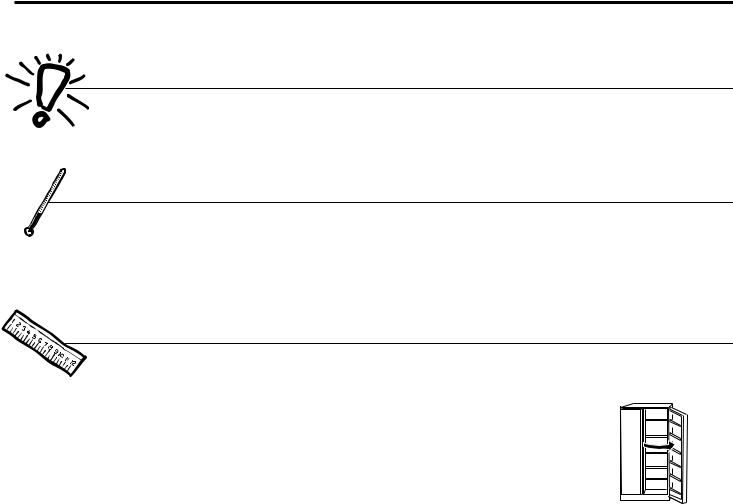
Preparing to install the refrigerator.
Read these instructions completely and carefully.
Water Supply to the Icemaker (on some models)
If the refrigerator has an icemaker, it will have to be connected to a cold water line.
Refrigerator Location
A water supply kit (containing copper tubing, shutoff valve, fittings and instructions) is available at extra cost from your dealer.
Do not install the refrigerator where the temperature will go below 60°F (16°C) because it will not run often enough to maintain proper temperatures.
Clearances
Install it on a floor strong enough to support it fully loaded.
Allow the following clearances for ease of installation, proper air circulation, plumbing and electrical connections:
If the refrigerator is against a wall on either side, allow the following door clearances on each side for a 90° door opening:
20’, 22’, 25’ and 27’ Models
Sides |
5/8″ (15 mm) |
Top |
1″ (25 mm) |
Back |
1″ (25 mm) |
If built-in, allow 7/8″ (22 mm) for hinge covers.
|
24’ Model |
28’ Model |
30’ Model |
Sides 1/8″ (3 mm) |
1/8″ (3 mm) |
1/8″ (3 mm) |
|
Top |
1″ (25 mm) |
1/8″ (3 mm) |
1/8″ (3 mm) |
Back |
1/2″ (13 mm) 1/2″ (13 mm) |
1/2″ (13 mm) |
|
If built-in, allow 7/8″ (22 mm) for hinge covers.
20’, 22’, 24’, 25’, 28’ and 30’ models
3/4″ (19 mm)
27’ models |
90° |
1 1/2″ (38 mm)
20
